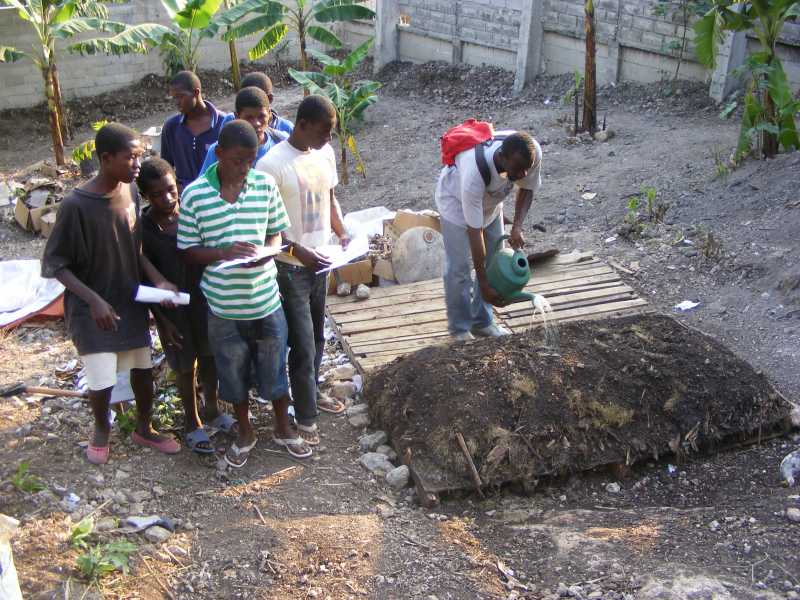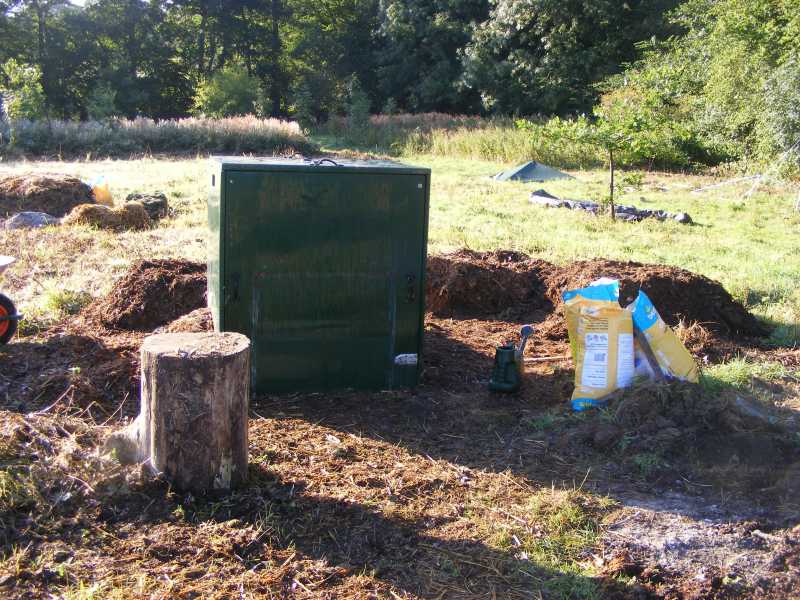- Forum
- categories
- Sanitation systems
- Treatment of wastewater, sludges, organic waste, excreta
- Composting
- Composting with hot box method (Howard-Higgins system)
Composting with hot box method (Howard-Higgins system)
64k views
- joeturner
-
 Less
Less- Posts: 717
- Karma: 23
- Likes received: 185
richard higgins wrote:
The Howard-Higgins system HH -2 is unique and does not seem to be carried out any where except by us. We do not make a 'sludge compost.' We make an optimum nitrogenous compost/fertilizer of the highest value. We now make a seed compost too. This can sell at prices higher than all the other special fertilizer supplements that you can buy. IE., seaweed meal,garden potash or poultry based pelleted manure,etc., It is made completely from garbage and human waste.
I have asked you for proper proof and asked technical questions about this system several times. Everything else you say is nonsense whilst you refuse to respond to those important questions.
There needs to be a revival in the manufacture of compost made with human waste.
This is what we do. Our training centre is open to the public and we have already course takers from various countries all of whom are not on the SuSanA conference.
I think the vast majority composting of sludge is a misnomer and that the claims you make are unproven and probably dangerous. Prove me wrong.
Please Log in to join the conversation.
You need to login to reply> any sludge compost is a great idea.
The Howard-Higgins system HH -2 is unique and does not seem to be carried out any where except by us. We do not make a 'sludge compost.' We make an optimum nitrogenous compost/fertilizer of the highest value. We now make a seed compost too. This can sell at prices higher than all the other special fertilizer supplements that you can buy. IE., seaweed meal,garden potash or poultry based pelleted manure,etc., It is made completely from garbage and human waste.
There needs to be a revival in the manufacture of compost made with human waste.
This is what we do. Our training centre is open to the public and we have already course takers from various countries all of whom are not on the SuSanA conference.
Richard Higgins
co. chair WG5
Please Log in to join the conversation.
You need to login to reply- joeturner
-
 Less
Less- Posts: 717
- Karma: 23
- Likes received: 185
Re: Peepoo bags in Kenyan urban slums: experiences, ideas and research
Please Log in to join the conversation.
You need to login to replyRe: Composting with hot box method (Howard-Higgins system)
In our trials with SuSan Design and New Directions Foundation last January 2012 we successfully digested PeePoo bags very quickly in the Howard-Higgins system.
In a 1.5m3 prototype unit we put in 300 MHM pads, 200 PeePoo bags and a weeks sanitation from 36 houses. All inputs had disappeared within 14 days.
Later testing proved there were no harmful pathogens found according to the animal bi products regs 142/2011.
adding 300 MHM.AVI
The material then goes on to mature into a finely divided saleable fertilizer in 76 days.
Also in at the Haiti earthquake of 2010 we digested PeePoo bags brought to the site of New Directions Foundation by OXFAM.
This site got the full approval of Professor Bob Reed of WEDC, Loughborough University.
The two trained managers, awarded certificates of proficiency, with professor Bob Reed present, went on to get jobs in recycling with CRS (Catholic Relief Services)
Videos of these events at the Haiti earthquake can be viewed at www.suaglon.co.uk
Richard Higgins
New Directions Foundation
Attachments:
-
36bioliner...pear.JPG (Filesize: 89KB)
-
 studentsinHaiti.jpg
(Filesize: 81KB)
studentsinHaiti.jpg
(Filesize: 81KB)
-
15marchwPr...Reed.JPG (Filesize: 41KB)
Please Log in to join the conversation.
You need to login to reply- joeturner
-
 Less
Less- Posts: 717
- Karma: 23
- Likes received: 185
edit: I found this report on Richard's website discussing his work in Haiti, which also mentions the peepoo trial.
It appears that in Haiti, no pathogens were directly measured. The assessment of pathogen destruction was made via non-continuous temperature monitoring.
Richard states:
Scientific – apart from the early work of Howard in the title ‘The Lost Science of Organic Cultivation’ Higgins set up a trial for full analysis at the Waltham pet center in the UK.
This is a research centre owned by the MARS group where dogs are bred solely for
nutritional purposes. 200 dog wastes were added daily in paper bags and the resident
scientists analysed the ‘30 day’ old product, at four different time intervals. All samples were found to be free of pathogens and ‘chemically equal to earth’. We did not have the facility to have the end product tested in Haiti, nor were we equipped with the basic long probe thermometer but by following the strict time pattern of the operating system (and with simple temperature monitoring) the safe remediation of human effluent is easily effected tothis same level
I'll leave you to consider the flaws of this proceedure and whether the resulting compost can be confidently claimed to be free of pathogens given that the text appears to suggest it is solely based on a graph from the Humanure handbook.
I don't know enough about the breakdown of cholera to know if this system can be described as 'cholera safe'.
Please Log in to join the conversation.
You need to login to reply- joeturner
-
 Less
Less- Posts: 717
- Karma: 23
- Likes received: 185
Richard's linkedIn page says
The system safely digested the sanitation of 36 houses, 300 MHM pads and 200 Oxfam PeePoo bags in the first 14 day period and went on to prove negative in the testing for harmful pathogens according to the ABP regs/2011 for pathogen testing in sewage sludge. A world first in Environmental waste management.
I'm not sure what the ABP regs are, but it sounds like the Animal Byproducts Order in the UK. I don't know why you'd be treating sludge to meet a British standard for animal byproducts.
I am not familiar with this standard, does it even measure Helminths? Why have you not tested it to a sludge standard?
Please Log in to join the conversation.
You need to login to replyThank you very much for your post. The WG5 factsheet is probably not the best medium to make the findings of your trials known as the factsheet is a lot more generic in nature and it is probably too early to include your findings in the chapter on reuse examples.
However I am sure that many people in the group would be interested to get more in-depth information on the trials you did. So if you could share you results via this forum or if you have a corresponding paper that we could circulate via the WG5 mailing list, that would be marvellous.
Thanks and best regards
rob
Senior Project Coordinator - Capacity Development
German Toilet Organization
Phone: +49-(0)30-41934345
Email: This email address is being protected from spambots. You need JavaScript enabled to view it.
www.germantoilet.org
www.washnet.de
Please Log in to join the conversation.
You need to login to replybarisot wrote: Regularly I dropped on the Hot Box and the Howard Higgins composting method. It seems to be a simple and efficient method for faecal treatment. The Howard Higgins method on pallets as applied in Haiti might be very useful in an emergency situation but hardly under normal circumstances. Therefore it would be interesting to get more information on the Hot Box, how they are operated and on what principles they are based in order to figure out the pros and cons.
Among different options for faecal treatment terra preta sanitation (TPS)with the application of a microbial mix after defecation are an interesting way to stabilize faecal matter and to circumvent the problem of ventilation.
Sanitization of faecal matter with ammonia (urea) seems to be a safe and simple method with the additional advantage that sanitizing and composting could be done at different sites. Furthermore less stringent rules could be applied in composting as the base material is safe.
The combination of both methods has to overcome an obstacle. Faecal stabilization in TPS is based on keeping low the pH. On the other hand ammonia treatment works only at a relatively high pH.
The missing link would be a cheap method to raise the pH.
Hmm, the waste-product of biodiesel production glycerin/glycerol is at a quite high pH after leaving the biodiesel production. In addition it would probably be a nice power-boost for thermophilic composting as it is a form of sugar that can be utilized by most bacteria.
One problem I see is that after sanitizing with urea you will have a lot of NH3/NH4 in the feacal material, that will make it very unpleasant (and even toxic) to work with if you plan to put that stuff into a composting site afterwards. Especially at higher temperatures it will degas and thus produce an extreme smell.
Please Log in to join the conversation.
You need to login to replyas you concluded your trials in Uganda, could you post the results? I would be especially interested in systematic data about the helminth eggs removal, do you have before - after combined with temperature?
Thanks in advance.
Christoph
Please Log in to join the conversation.
You need to login to reply- barisot
-
Less
- Posts: 2
- Likes received: 0
Re: possible addition of up date for factsheet WG5
Among different options for faecal treatment terra preta sanitation (TPS)with the application of a microbial mix after defecation are an interesting way to stabilize faecal matter and to circumvent the problem of ventilation.
Sanitization of faecal matter with ammonia (urea) seems to be a safe and simple method with the additional advantage that sanitizing and composting could be done at different sites. Furthermore less stringent rules could be applied in composting as the base material is safe.
The combination of both methods has to overcome an obstacle. Faecal stabilization in TPS is based on keeping low the pH. On the other hand ammonia treatment works only at a relatively high pH.
The missing link would be a cheap method to raise the pH.
Please Log in to join the conversation.
You need to login to replyWe successfully composted the human effluent of 720 people, 300 MHM pads and 200 Peepoo bags in a 1.5 cubic meter Hot Box with the Howard-Higgins system. No pathogens were found in the biological testing at 90 days.
Richard Higgins
New Directions Foundation
Please Log in to join the conversation.
You need to login to replyHello Dena,
It would be great to try and introduce our thermophilic system into the ether of Australia.
So far we have had no response from anyone we have written to in Australia...IE., Permaculture people.
Lets hope there is some interest there.
[posted by Richard Higgins]
Located at Deutsche Gesellschaft für Internationale Zusammenarbeit (GIZ) GmbH, Bonn, Germany
Follow us on facebook: www.facebook.com/susana.org, linkedin: www.linkedin.com/company/sustainable-sanitation-alliance-susana.
Attachments:
-
 ThermoFactory.jpg
(Filesize: 89KB)
ThermoFactory.jpg
(Filesize: 89KB)
Please Log in to join the conversation.
You need to login to reply- Forum
- categories
- Sanitation systems
- Treatment of wastewater, sludges, organic waste, excreta
- Composting
- Composting with hot box method (Howard-Higgins system)








